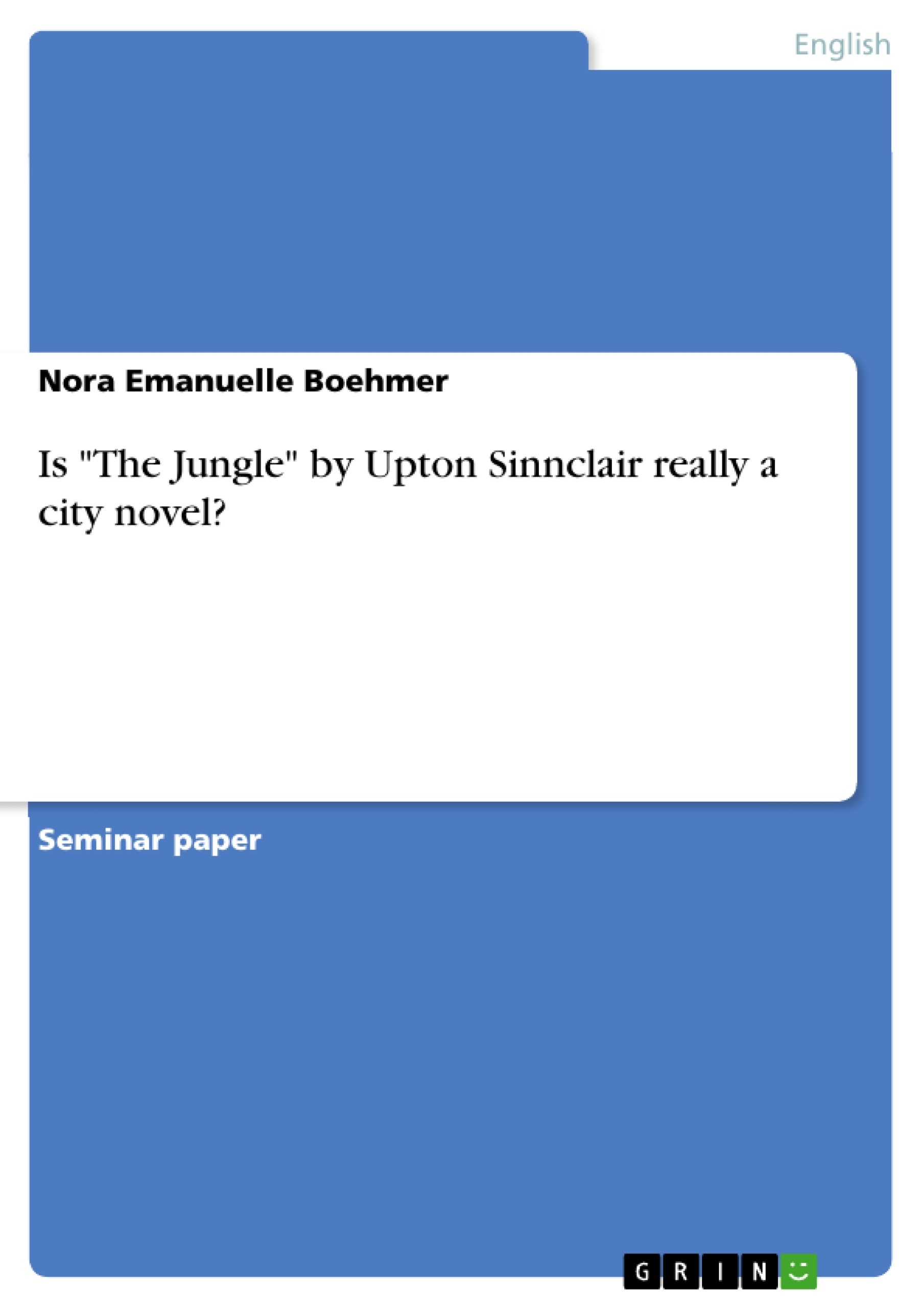The question being discussed in this paper is whether or not Upton Sinclair’sThe Junglecan be regarded as one of the great city novels in American Literature. It is a rather difficult question that made me think of a painting I discovered when I was searching for literature about this topic. It can be seen at the front page of this paper. The painting is calledIch und die Stadtand was painted by an artist called Ludwig Meidner in 1913. It appeared along with other paintings of city impressions in a book carrying the title of Meidner’s painting,Ich und die Stadt.The painting is supposed to be depicting a person and his city, but is that really what the viewer can see? Is it not a mere chaos that is presenting itself in this piece of art? There are houses, telegraphing poles, chimneys, patches of green, smoke, streets and in the front we can see a face. It is looking at us, the observer of the painting, in a little provocative way. The interpreters of the painting used a quote by Meidner himself that can be found in his book Im Nacken das Sternenmeer (1918). To express his thoughts about this face in the painting, he said: “Was peitscht mich denn so in die Stadt hinein? Was ras ich verrückt heerstraßenlang?…”. An this is what most people wonder about the city, why is this place like a magnet? The painting is drawn with sudden strokes of the paintbrush, reflecting the impulsiveness of the city, the speed, which is part of the city. The painting does not express any calmness, there are no places to rest the eye on. What I also found striking is that there is no symbiosis between human being and the city, they are in the same painting but do not seem to be forming a unit. The thought I had when I looked at the painting was that for me it represented Jurgis and Chicago. Jurgis as the lost face in the front of the painting being put in the centre of attention without even wanting to be there and in the back, Chicago a city of chaos. Jurgis, the face, seems to be wondering if he should really dive into that chaos; maybe this is the moment where he last looks back on what he is leaving behind before going in the city. And is that painting really depicting a city or is it depicting the person, wanting to be in the city? And isThe Junglereally depicting the city or is it depicting what the city does to its inhabitants? Or is that the same? In this paper I will focus on Sinclair’s description of Chicago inThe Jungle. [...]
Table of Contents
- Introduction
- Plot synopsis of Upton Sinclair's The Jungle
- Analysis
- The city at the turn of the century-various authors' viewpoints describing the city as portrayed in The Jungle
- The title of The Jungle
- Packingtown - a metaphor
- Other city aspects examined (advertisements, electric lights)
- The city image represent in The Jungle
- Conclusion
- Literature
Objectives and Key Themes
This paper analyzes Upton Sinclair's The Jungle to determine whether it can be considered one of the great city novels in American literature. The author examines the depiction of Chicago in the novel, comparing Sinclair's vision to that of other contemporary authors who wrote about cities. The paper explores various themes related to the city, including the impact of industrialization on urban life, the struggles of immigrants in a new environment, and the corrupting influence of wealth and power.
- The representation of urban life in The Jungle
- The immigrant experience in Chicago's Packingtown
- The corrupting influence of industrial capitalism
- The role of the city as a catalyst for social and economic inequality
- The impact of poverty and exploitation on individual lives
Chapter Summaries
- Introduction: The paper begins with a discussion of a painting by Ludwig Meidner called Ich und die Stadt. The painting depicts a city as a chaotic and overwhelming place, and the author uses this image to draw parallels between the painting and the themes of Sinclair's The Jungle.
- Plot synopsis of Upton Sinclair's The Jungle: This section provides a summary of the novel's plot, focusing on the experiences of Jurgis Rudkus, a Lithuanian immigrant who comes to Chicago with hopes of a better life. The summary follows Jurgis' journey as he experiences the harsh realities of working in the meatpacking industry, the exploitation of immigrants, and the corrupting influence of industrial capitalism.
- Analysis: This section delves into the author's analysis of The Jungle as a city novel. The author discusses the various perspectives on the city at the turn of the century, examining how Sinclair's portrayal of Chicago aligns with or deviates from these perspectives. This section also examines the significance of the title The Jungle, the role of Packingtown as a metaphor for the city, and other aspects of urban life depicted in the novel.
Keywords
The paper focuses on the themes of urban life, immigration, industrial capitalism, social inequality, and exploitation. The work explores Sinclair's portrayal of Chicago in The Jungle, drawing on various authors' perspectives on the city during the turn of the century. This analysis includes the significance of the title, the metaphor of Packingtown, and the various aspects of the city's depiction in the novel.
- Quote paper
- Nora Emanuelle Boehmer (Author), 2005, Is "The Jungle" by Upton Sinnclair really a city novel?, Munich, GRIN Verlag, https://www.grin.com/document/62296



